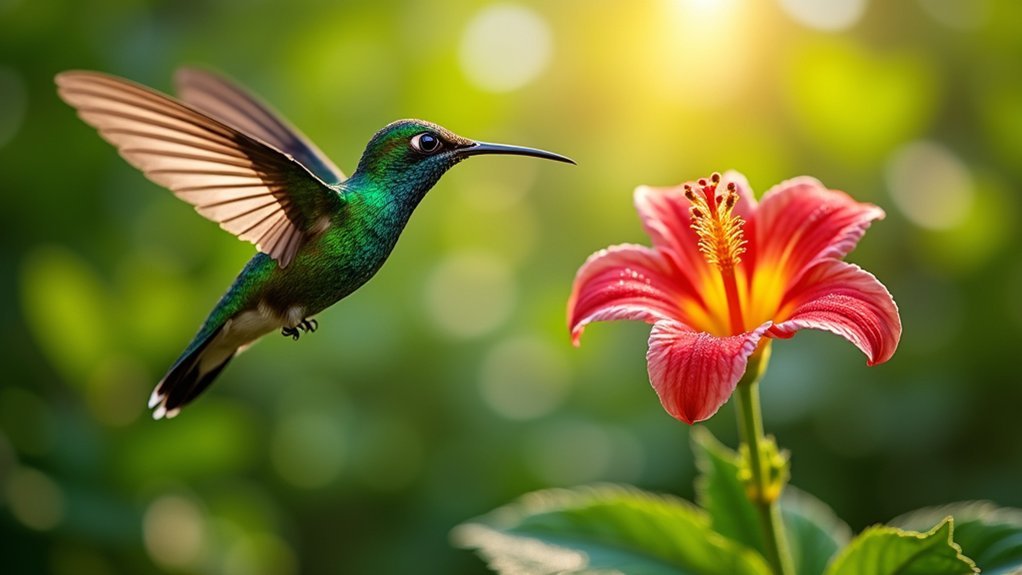To photograph rare city hummingbirds, establish multiple feeding stations with native plants like bee balm and salvia in your urban garden or balcony. Use high-speed flash techniques at 1/8000-1/10,000 second with flashes positioned at 45-degree angles to freeze wing motion. Set up your equipment early and observe feeding patterns to anticipate behavior—position yourself with a dark backdrop for stunning contrast. These urban sanctuaries can attract even the most elusive hummingbird species for your lens.
Finding Prime Urban Locations for Rare Hummingbird Sightings

Where should you position yourself to capture these elusive winged jewels in the concrete jungle? Urban gardens and parks with native flowering plants like bee balm and salvia are your best bet.
Urban sanctuaries filled with native blooms offer prime territory for spotting these iridescent aerial acrobats.
These spots often become hotspots for rare hummingbird sightings.
Don’t overlook rooftop gardens and balconies, which provide excellent vantage points for photographing hummingbirds in flight.
Install a hummingbird feeder with 20% sugar water solution, ensuring a clean feeding hole to attract various hummingbird species.
Track seasonal migration patterns through online birdwatching platforms and local wildlife groups that report sightings.
For maximum success, set up multiple feeders near nectar-rich flowers with minimal human disturbance.
Mastering High-Speed Flash Techniques in Limited Urban Spaces
While urban environments present unique challenges for wildlife photography, capturing hummingbirds in city settings requires specialized flash techniques to freeze their lightning-fast movements.
Set your flash to high-speed settings between 1/1000 and 1/10,000 of a second to capture crisp, detailed hummingbird shots.
Position multiple flashes at 45-degree angles to your feeder, creating balanced lighting that accentuates the birds’ iridescent plumage without harsh shadows.
Start with 1/8 to 1/16 power to allow rapid cycling without overheating your equipment.
Use a MIOPS Smart Trigger or similar remote trigger to minimize disturbances in confined spaces.
For maximum contrast in your photograph, place a dark backdrop behind your subject—this simple trick makes vibrant hummingbird colors pop dramatically against typical urban backgrounds.
Creating Natural Setups That Attract City-Dwelling Hummingbirds

Creating a natural environment in your urban space serves as the foundation for successful hummingbird photography. Plant hummingbird-friendly flowers like bee balm, salvia, and trumpet vine to create a vibrant natural habitat that appeals to these tiny visitors.
Transform your urban space into a hummingbird haven with native flowering plants that invite these jeweled visitors to your lens.
Consider feeder hanging in locations with open shade, ensuring they’re frontlit by morning or evening sun for ideal photography conditions.
Mix your setup with quality hummingbird feeders filled with fresh nectar (1:4 sugar-to-water ratio). Replace nectar every few days and clean feeders regularly to prevent bacterial growth.
Position natural perches near feeding stations to capture stunning shots of perched birds between flights. Understanding hummingbirds’ behavior will help you anticipate their movements.
Finally, install multiple feeders at different locations to reduce territorial conflicts and maximize your photography opportunities.
Frequently Asked Questions
What Camera Settings Are Best for Hummingbird Photos?
For hummingbird photos, you’ll want fast shutter speeds (1/1000-1/10,000), low ISO (100-400), wide aperture (f/2.8-f/5.6), and burst mode. Don’t forget to experiment with manual flash for balanced lighting.
What Shutter Speed for Hummingbirds?
For photographing hummingbirds, you’ll need at least 1/1000 second to freeze wing motion in flight. You can use 1/500 second for perched birds, but faster speeds like 1/4000 or 1/8000 work best in bright conditions.
What Lens Is Best for Hummingbird Photography?
For hummingbird photography, you’ll want a lens with at least 300mm focal length. A 400-600mm telephoto gives better background isolation, while fast autofocus and image stabilization are essential for capturing these quick, tiny subjects.
How to Photograph Hummingbirds Without Flash?
To photograph hummingbirds without flash, use fast shutter speeds (1/1000+), shoot in morning or evening light, set a wide aperture, position yourself in shade, and use burst mode to capture their quick movements.
In Summary
While urban hummingbird photography presents unique challenges, you’ve now learned where to find these elusive birds, how to capture their lightning-fast movements with proper flash techniques, and ways to create attractive natural setups in city environments. With practice and patience, you’ll soon be capturing stunning images of rare hummingbird species without leaving the concrete jungle. Remember, successful urban wildlife photography combines preparation, technical skill, and a keen understanding of your subjects.





Leave a Reply